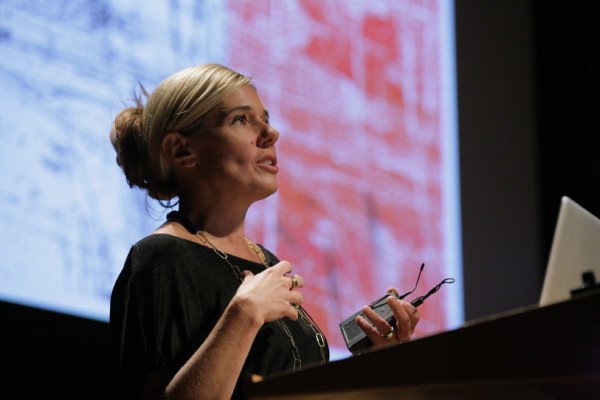Originally from Brazil, Marina talked about the influence her homeland has had on her work. Colour, rhythm and improvisation was prevalent in her solutions just as it was in her archive of photographs from home, and the optimism in adversity displayed in the favelas is a spirit she admired.
When on the subject of branding spaces, it was clear that each solution was born from collaboration. Whether working with the architect, client, illustrators or artists, each piece says something about the place it lives within. Take their work for The Tate, for example. The client’s ambition to create a more democratic space, somewhere the mass can experience and engage with art, was helped realised by using a less academic, more ‘high street’ approach to signage. The mark itself is fluid, generous and recessive, elevating artists and collaborators to the surface and our focus. The experience at The Tate is all about the art, after all.
Not all museum spaces are like that though. Where once upon a time gallery spaces were like white boxes, blank canvases for their exhibits, alternate spaces such as the Guggenheim in New York and the Louvre in Paris are as famed for their architecture as they are for their art. In those iconic forms lies challenges, as such exhibition spaces have discovered that once visitors have experienced the building they are less likely to return to experience the actual art. To build a coherent relationship between the building, the content and the curation is the key.The solution for the Southbank Centre is distinctive, and embodies not only the brutal forms of the structure itself, but also celebrates the converging art forms that the gallery champions. But within the space the identity system demonstrates its flexibility, becoming more elegant and polished against the rougher, harsh architecture. The tone of voice of the identity compliments the space, as opposed to competing within it.

Marina Willer
And in the case of 1111 Lincoln, a car park inspired by some sense of tropical modernity, Marina admitted that the building, so distinctive and iconic, is the brand. Four horizontal numerals spelling the address with a subtle nod to the number of floors marks the building, but the experience of the space itself is enough to make it memorable.
Text: Matt Judge, Design Assembly











 Photo: Gerhard Kassner
Photo: Gerhard Kassner











Pingback: Fontblog | TYPO London 2011 im Rückblick